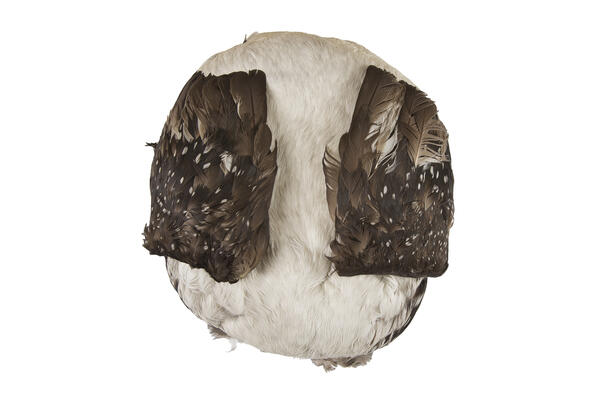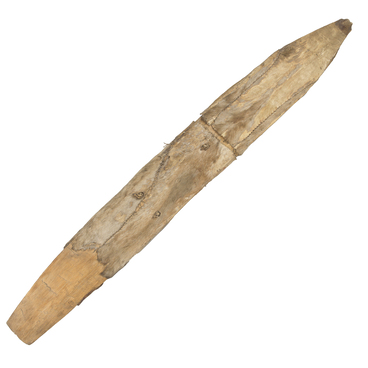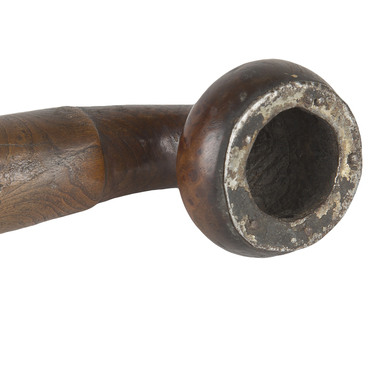An Evenk hat exhibited in the Transbaikal Regional Museum of Local Lore was made of loon skin, which is a small waterfowl the size of a small goose. Its body is 58–73 centimeters in length, while its wingspan is 110–130 centimeters. The Arctic loon lives in northern regions, including Transbaikal.
The Evenks had a loon cult: the bird was especially revered and often depicted on clothing items. In many legends the loon was involved in the creation of the world and helped shamans to communicate with spirits.
Researchers have suggested that such feathered headdresses were part of the Evenk ritual clothing. For instance, during hunting — which was accompanied by ritual ceremonies — men used to wear a “meta” — skin of a goat, a roe deer, or a young deer with antlers and ears. The same word was used by the Eastern and Western Evenks to denote ordinary headwear.
The Transbaikal Evenk population had different kinds of headwear. Women wore a “capor” — a cap made of a skin from the frontal part of a deer. In some Transbaikal regions, such hats were made until the 1930s. The capors were decorated with beaded embroidery and pendants. In the Ilimpiyskiy District, present-day territory of Krasnoyarsk Krai, such hats were worn by men as well.
Moreover, the Evenks wore another headdress, known as “avun”. It was made of two long longitudinal strips of fur that covered the ears of the wearer and a short one that covered the back of their head and vertex. On top of the head there was a hole through which the braids were passed. Later it was sewn up with an oval piece of fur.
Furthermore, the Evenks wore shawls. Men rolled them into a bundle, wrapping them around their heads and tying them at the back under their hair. Women covered the back of their heads and tied the ends at the top of their heads. In winter, they wore a warm woolen shawl to protect their face and ears from harsh frosts.
The Evenks did not cut their hair, wearing it very long instead. For convenience, it was tied up in different ways. Young girls had thin braids, and married women had two thick braids. Over time, the Evenks began to cut their hair, and the tradition has almost disappeared.
The Evenks had a loon cult: the bird was especially revered and often depicted on clothing items. In many legends the loon was involved in the creation of the world and helped shamans to communicate with spirits.
Researchers have suggested that such feathered headdresses were part of the Evenk ritual clothing. For instance, during hunting — which was accompanied by ritual ceremonies — men used to wear a “meta” — skin of a goat, a roe deer, or a young deer with antlers and ears. The same word was used by the Eastern and Western Evenks to denote ordinary headwear.
The Transbaikal Evenk population had different kinds of headwear. Women wore a “capor” — a cap made of a skin from the frontal part of a deer. In some Transbaikal regions, such hats were made until the 1930s. The capors were decorated with beaded embroidery and pendants. In the Ilimpiyskiy District, present-day territory of Krasnoyarsk Krai, such hats were worn by men as well.
Moreover, the Evenks wore another headdress, known as “avun”. It was made of two long longitudinal strips of fur that covered the ears of the wearer and a short one that covered the back of their head and vertex. On top of the head there was a hole through which the braids were passed. Later it was sewn up with an oval piece of fur.
Furthermore, the Evenks wore shawls. Men rolled them into a bundle, wrapping them around their heads and tying them at the back under their hair. Women covered the back of their heads and tied the ends at the top of their heads. In winter, they wore a warm woolen shawl to protect their face and ears from harsh frosts.
The Evenks did not cut their hair, wearing it very long instead. For convenience, it was tied up in different ways. Young girls had thin braids, and married women had two thick braids. Over time, the Evenks began to cut their hair, and the tradition has almost disappeared.



